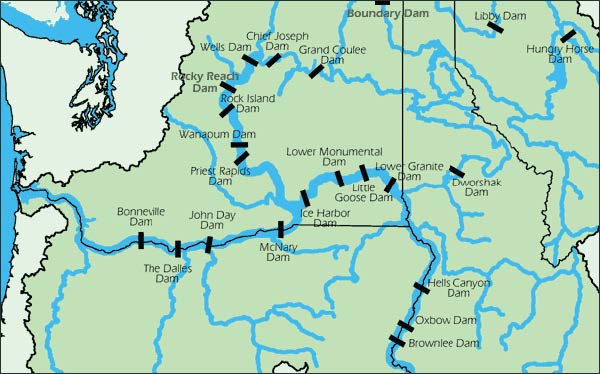forum
library
tutorial
contact

2016 Columbia/Snake Survival
Rates Mixed for Juvenile Fish
by Laura Berg
NW Fishletter, December 5, 2016
|
the film forum library tutorial contact |

|
2016 Columbia/Snake Survival
by Laura Berg
|
 Estimated survival rates for this year's spring-migrating juvenile fish passing through the Columbia and Snake river system show a mixed bag of results.
Estimated survival rates for this year's spring-migrating juvenile fish passing through the Columbia and Snake river system show a mixed bag of results.
Paul Wagner of NOAA Fisheries shared 2016 preliminary survival estimates for 2016 with the Fish Passage Advisory Committee meeting Oct. 4, and at the Technical Management Team meeting the following day.
The 2016 report by the Northwest Fisheries Science Center covers juvenile spring Chinook, steelhead and sockeye moving downstream on the Snake and Columbia rivers April 1-June 15.
Wagner said most Snake River hatchery spring Chinook survived to Lower Granite Dam at higher levels than the 10-year average.
However, estimated survival to Bonneville Dam of the combined Snake River hatchery and wild-yearling Chinook fell slightly below the long-term average, the 22-page memo said. From the Snake River trap to the Bonneville Dam tailrace, the survival rate was 33 percent.
The survival study, based on PIT-tag data, started in 1993 and is funded by BPA.
It was a similar story for Snake River hatchery and wild steelhead. Their survival was above-average through the Snake system, but the combined steelhead survival estimate from the Snake River trap to the Bonneville tailrace was 44.4 percent below average.
For Snake River sockeye, survival estimates were also below average. Wagner said a fungus observed on the fish at Lower Granite likely caused the poor survival. He noted that the Lower Granite-to-Bonneville estimate of 11 percent was the second-lowest survival rate in the 20-year sample.
Columbia and Snake River dams in the U.S. Credit: NW Council For juvenile Chinook originating from the upper Columbia, passage survival was about average this year. Estimated survival from the McNary Dam tailrace to Bonneville Dam tailrace was 80.7 percent. There's no data from farther upstream on the Columbia "because of limited PIT-tag detection capabilities at mid-Columbia River PUD dams," the memo states.
Mid- and lower Columbia River steelhead passage declined and fell below the 10-year average. For hatchery steelhead originating from the upper Columbia in 2016, estimated survival from McNary Dam tailrace to Bonneville Dam tailrace was 48.7 percent, lower than prior years.
Estimates for upper Columbia River sockeye survival were also less than average. "The reason for low survival among these fish is not known at this time," the draft memo says.
Environmental conditions this year were similar to, but not as extreme as, 2015, when juvenile downstream passage was generally well below average.
Wagner told TMT that the Columbia basin experienced early runoff with the peak occurring in April and again May 15. Rapid snowmelt typically happens in mid-June or later, but in 2016 high flows occurred early.
Smolt passage at the projects also came earlier in the season than the average. By the beginning of May, the peak of Chinook and steelhead juveniles had passed Lower Granite.
Water supplies began to decline rapidly after May 20, and by June flows were low, Wagner said.
He said spill was near average until mid-May, when declining flows resulted in decreasing spill volumes.
Water temperatures in 2016 were warmer than average, but cooler than in 2015.
Transport of juvenile Chinook and steelhead was higher in 2016 than the previous year, but lower than in prior years. About 22 percent of Chinook and 23 percent of steelhead were transported.
The increase in transport, Wagner said, largely resulted from the early migration of both Chinook and steelhead. The high early flows contributed to faster travel times in 2016 than in prior years. But as flows decreased in May and June, travel times were "closer to the long-term average," the memo says.
Wagner said the use of spillway weirs and 24-hour spill helped speed up travel times.
At the Fish Passage Advisory Committee (FPAC) meeting, Margaret Filardo, biologist with the Fish Passage Center, said additional factors affected juvenile survival in 2016, including low flows in the Columbia because of the drawdown of Grand Coulee Dam for maintenance.
Tom Lorz, FPAC and TMT member from the Columbia River Inter-Tribal Fish Commission, suggested that the memo should more fully explore the effects of spill and system operations on juvenile survival in the lower river.
Other suggestions for improving the juvenile-survival report were also made at the TMT meeting. Wagner said he would pass on the recommendations to the regional fisheries science center for consideration.
The science center will provide final juvenile survival estimates--which may change as much as 3 to 4 percent--in the final report expected to be released in February or March.
learn more on topics covered in the film
see the video
read the script
learn the songs
discussion forum
